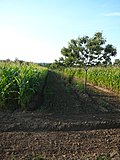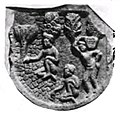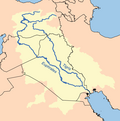Portal:Gardening
The Gardening Portal

Gardening is the process of growing plants for their vegetables, fruits, flowers, herbs, and appearances within a designated space. Gardens fulfill a wide assortment of purposes, notably the production of aesthetically pleasing areas, medicines, cosmetics, dyes, foods, poisons, wildlife habitats, and saleable goods (see market gardening). People often partake in gardening for its therapeutic, health, educational, cultural, philosophical, environmental, and religious benefits. Gardening varies in scale from the 800 hectare Versailles gardens down to container gardens grown inside. Gardens take many forms; some only contain one type of plant, while others involve a complex assortment of plants with no particular order. (Full article...)
Horticulture (from Latin: horti + culture) is the art and science of growing fruits, vegetables, flowers, trees, shrubs and ornamental plants. Horticulture is commonly associated with the more professional and technical aspects of plant cultivation on a smaller and more controlled scale than agronomy. There are various divisions of horticulture because plants are grown for a variety of purposes. These divisions include, but are not limited to: propagation, arboriculture, landscaping, floriculture and turf maintenance. For each of these, there are various professions, aspects, tools used and associated challenges -- each requiring highly specialized skills and knowledge on the part of the horticulturist. (Full article...)
General images -
Selected article -
Pollarding is a pruning system involving the removal of the upper branches of a tree, which promotes the growth of a dense head of foliage and branches. In ancient Rome, Propertius mentioned pollarding during the 1st century BCE. The practice has occurred commonly in Europe since medieval times, and takes place today in urban areas worldwide, primarily to maintain trees at a determined height or to place new shoots out of the reach of grazing animals.
Traditionally, people pollarded trees for one of two reasons: for fodder to feed livestock or for wood. Fodder pollards produced "pollard hay" for livestock feed; they were pruned at intervals of two to six years so their leafy material would be most abundant. Wood pollards were pruned at longer intervals of eight to fifteen years, a pruning cycle tending to produce upright poles favored for fencing and boat construction. Supple young willow or hazel branches may be harvested as material for weaving baskets, fences, and garden constructions such as bowers. Nowadays, the practice is sometimes used for ornamental trees, such as crape myrtles in southern states of the US. (Full article...)
Selected image

Related portals
Did you know -
- ... that in 2023, a sculpture garden in Praunheim displayed abstract works by Hans Steinbrenner from different periods of his life, and corresponding works by his friends and students?
- ... that none of the actors in Poppy Garden, a film depicting a father and son's struggle for survival during the Colombian conflict, had previously acted in a film?
- ... that tea-garden labour leader Prem Oraon lost his right leg in 1970 during a protest against a factory closure?
- ... that controversy ensued when the painting Pleasure Garden was offered to the Robert McDougall Art Gallery?
- ... that Elisabeth Whittle, a garden historian, considers the gardens at Powis Castle to be the most important and magnificent in Wales?
- ... that much of what we know of medieval gardens comes from illuminated manuscripts?
- ... that bored soldiers during the siege of Ak-Mechet began stealing watermelons from gardens outside the enemy fortress?
- ... that popular garden plants like malfurada often escape from cultivation and become invasive?
Things you can do
- This list is transcluded from the tasks list page. To edit the list, click here
 |
Here are some tasks awaiting attention:
|
WikiProjects
Topics
Categories
Associated Wikimedia
The following Wikimedia Foundation sister projects provide more on this subject:
-
Commons
Free media repository -
Wikibooks
Free textbooks and manuals -
Wikidata
Free knowledge base -
Wikinews
Free-content news -
Wikiquote
Collection of quotations -
Wikisource
Free-content library -
Wikiversity
Free learning tools -
Wiktionary
Dictionary and thesaurus
























































































